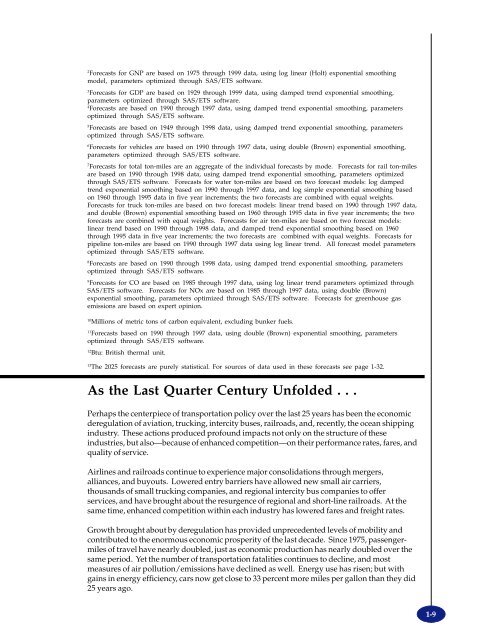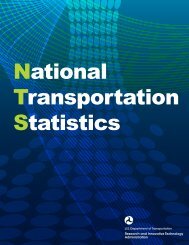TRANSPORTATION - BTS - Bureau of Transportation Statistics
TRANSPORTATION - BTS - Bureau of Transportation Statistics
TRANSPORTATION - BTS - Bureau of Transportation Statistics
Create successful ePaper yourself
Turn your PDF publications into a flip-book with our unique Google optimized e-Paper software.
2Forecasts for GNP are based on 1975 through 1999 data, using log linear (Holt) exponential smoothingmodel, parameters optimized through SAS/ETS s<strong>of</strong>tware.3Forecasts for GDP are based on 1929 through 1999 data, using damped trend exponential smoothing,parameters optimized through SAS/ETS s<strong>of</strong>tware.4Forecasts are based on 1990 through 1997 data, using damped trend exponential smoothing, parametersoptimized through SAS/ETS s<strong>of</strong>tware.5Forecasts are based on 1949 through 1998 data, using damped trend exponential smoothing, parametersoptimized through SAS/ETS s<strong>of</strong>tware.6Forecasts for vehicles are based on 1990 through 1997 data, using double (Brown) exponential smoothing,parameters optimized through SAS/ETS s<strong>of</strong>tware.7Forecasts for total ton-miles are an aggregate <strong>of</strong> the individual forecasts by mode. Forecasts for rail ton-milesare based on 1990 through 1998 data, using damped trend exponential smoothing, parameters optimizedthrough SAS/ETS s<strong>of</strong>tware. Forecasts for water ton-miles are based on two forecast models: log dampedtrend exponential smoothing based on 1990 through 1997 data, and log simple exponential smoothing basedon 1960 through 1995 data in five year increments; the two forecasts are combined with equal weights.Forecasts for truck ton-miles are based on two forecast models: linear trend based on 1990 through 1997 data,and double (Brown) exponential smoothing based on 1960 through 1995 data in five year increments; the tw<strong>of</strong>orecasts are combined with equal weights. Forecasts for air ton-miles are based on two forecast models:linear trend based on 1990 through 1998 data, and damped trend exponential smoothing based on 1960through 1995 data in five year increments; the two forecasts are combined with equal weights. Forecasts forpipeline ton-miles are based on 1990 through 1997 data using log linear trend. All forecast model parametersoptimized through SAS/ETS s<strong>of</strong>tware.8Forecasts are based on 1990 through 1998 data, using damped trend exponential smoothing, parametersoptimized through SAS/ETS s<strong>of</strong>tware.9Forecasts for CO are based on 1985 through 1997 data, using log linear trend parameters optimized throughSAS/ETS s<strong>of</strong>tware. Forecasts for NOx are based on 1985 through 1997 data, using double (Brown)exponential smoothing, parameters optimized through SAS/ETS s<strong>of</strong>tware. Forecasts for greenhouse gasemissions are based on expert opinion.10Millions <strong>of</strong> metric tons <strong>of</strong> carbon equivalent, excluding bunker fuels.11Forecasts based on 1990 through 1997 data, using double (Brown) exponential smoothing, parametersoptimized through SAS/ETS s<strong>of</strong>tware.12Btu: British thermal unit.13The 2025 forecasts are purely statistical. For sources <strong>of</strong> data used in these forecasts see page 1-32.As the Last Quarter Century Unfolded . . .Perhaps the centerpiece <strong>of</strong> transportation policy over the last 25 years has been the economicderegulation <strong>of</strong> aviation, trucking, intercity buses, railroads, and, recently, the ocean shippingindustry. These actions produced pr<strong>of</strong>ound impacts not only on the structure <strong>of</strong> theseindustries, but also—because <strong>of</strong> enhanced competition—on their performance rates, fares, andquality <strong>of</strong> service.Airlines and railroads continue to experience major consolidations through mergers,alliances, and buyouts. Lowered entry barriers have allowed new small air carriers,thousands <strong>of</strong> small trucking companies, and regional intercity bus companies to <strong>of</strong>ferservices, and have brought about the resurgence <strong>of</strong> regional and short-line railroads. At thesame time, enhanced competition within each industry has lowered fares and freight rates.Growth brought about by deregulation has provided unprecedented levels <strong>of</strong> mobility andcontributed to the enormous economic prosperity <strong>of</strong> the last decade. Since 1975, passengermiles<strong>of</strong> travel have nearly doubled, just as economic production has nearly doubled over thesame period. Yet the number <strong>of</strong> transportation fatalities continues to decline, and mostmeasures <strong>of</strong> air pollution/emissions have declined as well. Energy use has risen; but withgains in energy efficiency, cars now get close to 33 percent more miles per gallon than they did25 years ago.1-9
















